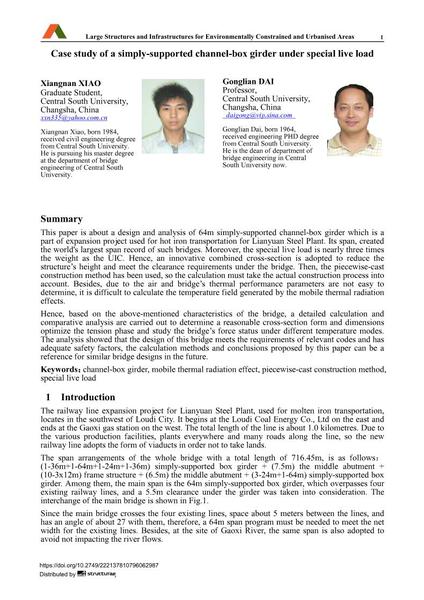Case study of a simply-supported channel-box girder under special live load

|
|
|||||||||||
Détails bibliographiques
| Auteur(s): |
Xiangnan Xiao
Gonglian Dai |
||||
|---|---|---|---|---|---|
| Médium: | papier de conférence | ||||
| Langue(s): | anglais | ||||
| Conférence: | IABSE Symposium: Large Structures and Infrastructures for Environmentally Constrained and Urbanised Areas, Venice, Italy, 22-24 September 2010 | ||||
| Publié dans: | IABSE Symposium Venice 2010 | ||||
|
|||||
| Page(s): | 614-615 | ||||
| Nombre total de pages (du PDF): | 8 | ||||
| Année: | 2010 | ||||
| DOI: | 10.2749/222137810796062987 | ||||
| Abstrait: |
This paper is about a design and analysis of 64m simply-supported channel-box girder which is a part of expansion project used for hot iron transportation for Lianyuan Steel Plant. Its span, created the world's largest span record of such bridges. Moreover, the special live load is nearly three times the weight as the UIC. Hence, an innovative combined cross-section is adopted to reduce the structure’s height and meet the clearance requirements under the bridge. Then, the piecewise-cast construction method has been used, so the calculation must take the actual construction process into account. Besides, due to the air and bridge’s thermal performance parameters are not easy to determine, it is difficult to calculate the temperature field generated by the mobile thermal radiation effects. Hence, based on the above-mentioned characteristics of the bridge, a detailed calculation and comparative analysis are carried out to determine a reasonable cross-section form and dimensions optimize the tension phase and study the bridge’s force status under different temperature modes. The analysis showed that the design of this bridge meets the requirements of relevant codes and has adequate safety factors, the calculation methods and conclusions proposed by this paper can be a reference for similar bridge designs in the future. |
||||
